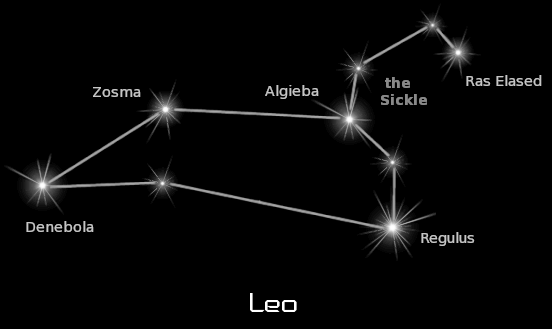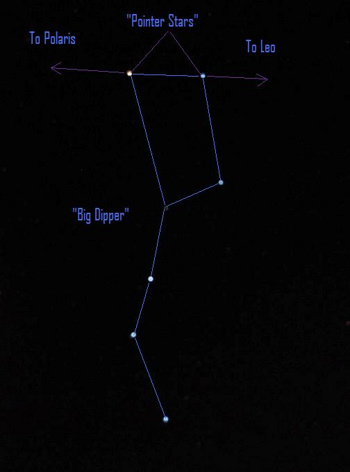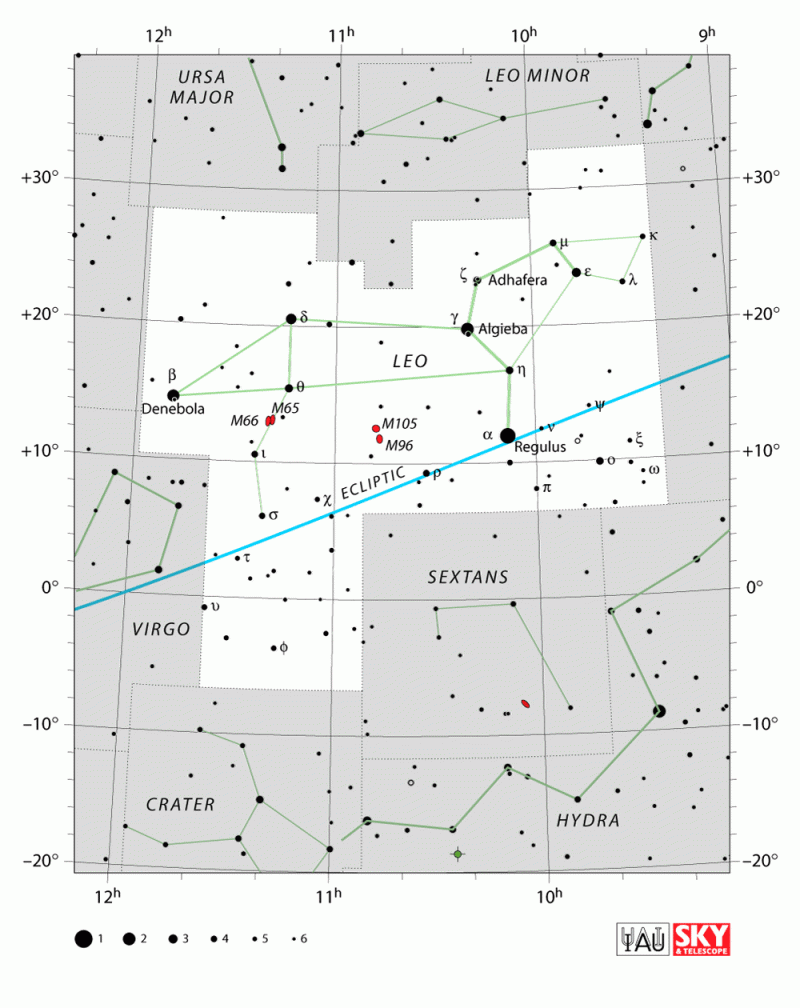
The bright star shining close to the waxing crescent moon on June 25, 2020 is Regulus, Heart of the Lion in the constellation Leo. The following night – June 26 – the moon will have moved some 14 degrees (14 moon-diameters) east on the sky’s dome, following its endless orbit around Earth. It’ll be closer to Denebola, the Lion’s Tail.
If you look carefully and have a dark-enough sky, you can make out patterns in the stars near both Denebola and Regulus. Denebola is part of a triangle of stars. Regulus is part of a pattern that looks like a backwards question mark, with Regulus – the brightest star in Leo – marking the bottom of this question mark pattern. This pattern of stars is called the Sickle. It’s not a constellation but instead an asterism, or recognizable pattern on the sky’s dome.

Regulus is part of a backwards question mark pattern known as the Sickle in Leo. Image via Derekscope.
As the moon continues to move from night to night, shifting eastward in front of the constellations of the zodiac, it’ll move onward away from Leo. How can you find Regulus then? One way is to look for the stars of the Sickle. Another way is to use the bowl of the Big Dipper to find your way to Regulus.

An imaginary line drawn between the pointer stars in the Big Dipper – the two outer stars in the Dipper’s bowl – points in one direction toward Polaris, the North Star, and in the opposite direction toward Leo.
Regulus is considered to be one of the four Royal Stars of ancient Persia. These Royal Stars mark the four quadrants of the heavens. They are Regulus, Antares, Fomalhaut, and Aldebaran.
Four to five thousand years ago, the Royal Stars defined the approximate positions of equinoxes and solstices in the sky. Regulus reigned as the summer solstice star, Antares as the autumn equinox star, Fomalhaut as the winter solstice star, and Aldebaran as the spring equinox star. Regulus is often portrayed as the most significant Royal Star, possibly because it symbolized the height and glory of the summer solstice sun. Although the Royal Stars as seasonal signposts change over the long coarse of time, they still mark the four quadrants of the heavens.

Chart of the constellation Leo via the IAU. The ecliptic depicts the annual pathway of the sun in front of the constellations of the zodiac. The sun passes in front of the constellation Leo each year from around August 10 to September 17, and has its yearly conjunction with the star Regulus on or near August 23.
Regulus is the only bright star to reside almost squarely on the ecliptic, that is, Earth’s orbital plane projected onto the sphere of stars. Regulus coincided with the summer solstice point some 4,300 years ago. In our time, the sun has its annual conjunction with Regulus on or near August 23, or about two months after the summer solstice, or alternatively, one month before the autumn equinox. Regulus will mark the autumn equinox point some 2,100 years into the future.
Eight years ago, in 2012, Regulus reached a place on the zodiac where it was precisely 150 degrees east of the March equinox point (and 30 degrees west of the September equinox point). Before that juncture, Regulus and the March equinox point were a little less than 150 degrees apart, and Regulus and the September equinox point were a little more than 30 degrees apart. For some astrologers, this instant at which Regulus was precisely 30 degrees west of the September equinox point marked the end of the Age of Pisces and the beginning of the Age of Aquarius. Click here to find out why.
Whether you enjoy the arcane speculation on the Royal Star Regulus and the Age of Aquarius – or not – that star now close to the moon has given definition to the ecliptic and the zodiac since time immemorial!
When does the Age of Aquarius begin?
Bottom line: Regulus is the brightest star in the constellation Leo the Lion. The moon can help you find it – and maybe the planets Jupiter and Venus – on the night of July 7, 2016.
Leo? Here’s your constellation
from EarthSky https://ift.tt/31gV1Cu

The bright star shining close to the waxing crescent moon on June 25, 2020 is Regulus, Heart of the Lion in the constellation Leo. The following night – June 26 – the moon will have moved some 14 degrees (14 moon-diameters) east on the sky’s dome, following its endless orbit around Earth. It’ll be closer to Denebola, the Lion’s Tail.
If you look carefully and have a dark-enough sky, you can make out patterns in the stars near both Denebola and Regulus. Denebola is part of a triangle of stars. Regulus is part of a pattern that looks like a backwards question mark, with Regulus – the brightest star in Leo – marking the bottom of this question mark pattern. This pattern of stars is called the Sickle. It’s not a constellation but instead an asterism, or recognizable pattern on the sky’s dome.

Regulus is part of a backwards question mark pattern known as the Sickle in Leo. Image via Derekscope.
As the moon continues to move from night to night, shifting eastward in front of the constellations of the zodiac, it’ll move onward away from Leo. How can you find Regulus then? One way is to look for the stars of the Sickle. Another way is to use the bowl of the Big Dipper to find your way to Regulus.

An imaginary line drawn between the pointer stars in the Big Dipper – the two outer stars in the Dipper’s bowl – points in one direction toward Polaris, the North Star, and in the opposite direction toward Leo.
Regulus is considered to be one of the four Royal Stars of ancient Persia. These Royal Stars mark the four quadrants of the heavens. They are Regulus, Antares, Fomalhaut, and Aldebaran.
Four to five thousand years ago, the Royal Stars defined the approximate positions of equinoxes and solstices in the sky. Regulus reigned as the summer solstice star, Antares as the autumn equinox star, Fomalhaut as the winter solstice star, and Aldebaran as the spring equinox star. Regulus is often portrayed as the most significant Royal Star, possibly because it symbolized the height and glory of the summer solstice sun. Although the Royal Stars as seasonal signposts change over the long coarse of time, they still mark the four quadrants of the heavens.

Chart of the constellation Leo via the IAU. The ecliptic depicts the annual pathway of the sun in front of the constellations of the zodiac. The sun passes in front of the constellation Leo each year from around August 10 to September 17, and has its yearly conjunction with the star Regulus on or near August 23.
Regulus is the only bright star to reside almost squarely on the ecliptic, that is, Earth’s orbital plane projected onto the sphere of stars. Regulus coincided with the summer solstice point some 4,300 years ago. In our time, the sun has its annual conjunction with Regulus on or near August 23, or about two months after the summer solstice, or alternatively, one month before the autumn equinox. Regulus will mark the autumn equinox point some 2,100 years into the future.
Eight years ago, in 2012, Regulus reached a place on the zodiac where it was precisely 150 degrees east of the March equinox point (and 30 degrees west of the September equinox point). Before that juncture, Regulus and the March equinox point were a little less than 150 degrees apart, and Regulus and the September equinox point were a little more than 30 degrees apart. For some astrologers, this instant at which Regulus was precisely 30 degrees west of the September equinox point marked the end of the Age of Pisces and the beginning of the Age of Aquarius. Click here to find out why.
Whether you enjoy the arcane speculation on the Royal Star Regulus and the Age of Aquarius – or not – that star now close to the moon has given definition to the ecliptic and the zodiac since time immemorial!
When does the Age of Aquarius begin?
Bottom line: Regulus is the brightest star in the constellation Leo the Lion. The moon can help you find it – and maybe the planets Jupiter and Venus – on the night of July 7, 2016.
Leo? Here’s your constellation
from EarthSky https://ift.tt/31gV1Cu

Aucun commentaire:
Enregistrer un commentaire